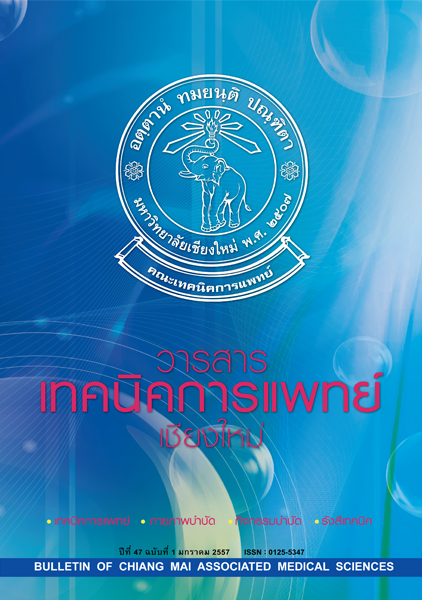Classification of carotid atherosclerotic plaque components using T2 mapping technique from magnetic resonance imaging
Main Article Content
Abstract
Introduction: Vulnerable plaque or soft plaque potentially increases risk of stroke. Accurate plaque characterization is a demand for treatments. To date, magnetic resonance imaging (MRI) using multiweighted images, T1 weighted (T1W), T2 weighted (T2E), and proton density weighted (PDW), is one of the best available tools. Due to the spin-spin relaxation property, different tissues reveal differences of T2s. We proposed T2 mapping for analysis plaque components, and to examine the possibility of using T2 mapping for carotid atherosclerotic plaque characterization.
Materials and methods: The 1.5 Tesla Philips, Acheiva Nova Dual, MRI scanner was employed to this study. T2 mapping images of a phantom made from 4 types of tissues were compared with T1W, T2W, and PDW images in term of accuracy. The comparisons were also performed on 4 different specimens and 8 volunteers diagnosed with carotid atherosclerosis. Axial images were acquired along the length of the phantoms with a scanning protocol including Spin echo-multi-echoes pulse sequence at 8 echo time (8TEs) from 15 ms. to 120 ms, inter-echo time 15 ms, field of view (FOV) 140x140 mm., matrix size 200x219, flip angle 90 degree, number of signal average (NSAs) 4, repetition time (TR) 1,333 ms, and slice thickness 3 mm. For the 8 human volunteers, axial images were acquired at the narrowest stenosis of the carotid artery with a scanning protocol slightly modified from that of the phantoms to suit for human scanning. The axial images from the 8 TEs were fit for T2 in each pixel with a simple mono-exponential model for generating T2 mapping. The accuracy of the images at the same location between the T2 mapping and the 3 weighted images were compared.
Results: The results from 4 known types of tissues showed that 4 major groups of tissues were classified with T2 mapping. Each group of the classification has a frequency over 60% of the maximum frequency, while T1W, T2W and PDW images were classified with intensity contrast into 2, 2 and 3 groups, respectively. However, the study in the specimen phantoms and the human volunteers were not validated due to little concordance of slice location between the images and those of the pathology section.
Conclusions: The T2 mapping showed more accurate classification in known types of tissue phantom compared to those of the T1W, T2W and PDW. However, the study in humans may need further study.
Bull Chiang Mai Assoc Med Sci 2014; 47(1): 37-44
Article Details
Personal views expressed by the contributors in their articles are not necessarily those of the Journal of Associated Medical Sciences, Faculty of Associated Medical Sciences, Chiang Mai University.


